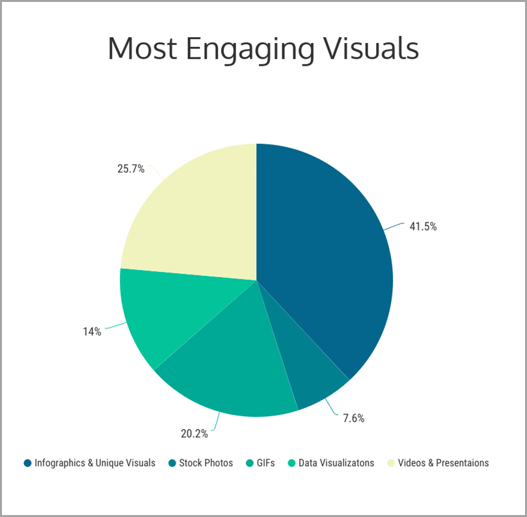
Adapting to RankBrain: Mastering SEO in the Age of AI
Gone are the days when well-written content optimized for search engines was enough to generate leads and drive huge traffic to websites. The vast number of content published daily has significantly impacted consumer behavior, resulting in fierce competition between marketers. Google-- the most popular search engine-- pushed the envelope even further by implementing revolutionary new SEO technologies. Today, if you’re serious about SEO, you NEED to optimize your content for RankBrain- a machine learning (AI) algorithm that Google uses to sort through its search results and understand search queries.
“The days of SEO being a game outsmarting algorithms are over. Today, content strategy and valuable, sustainable strategies are essential, not just tricks and links.” - Adam Audette, Chief Knowledge Officer of RKG.
Let’s check out some stats:
Google Statistics
-
Google processes 100 billion searches a month (that’s an average of 40,000 search queries every second)
-
91.47% of all internet searches are carried out by Google
-
Those searches are carried out by 1.17 billion unique users
-
Every day, 15% of that day’s queries have never been asked before
-
Google has answered 450 billion unique queries since 2003
-
60% of Google’s searches come from mobile devices
-
By 2014, Google had indexed over 130 trillion web pages
-
To carry out all these searches, Google’s data centre uses 0.01% of the world’s electricity, although it hopes to cut its energy use by 15% via AI
Content Statistics
-
On WordPress alone, 91.8 million blog posts are published every month
-
A 2011 study by AOL/Nielsen showed that 27 million pieces of content are shared every day
-
The top 3 content marketing tactics are social media content (83%), blogs (80%), and email newsletters (77%)
-
70% of marketers are creating more content today than they were a year ago
Content Consuming Trends
-
55% of all page views get less than 15 seconds of attention.
-
Visitors only read about 20% of the text on the average page (Jakob Nielsen)
-
The pattern in which people read online content isn’t from left-to-right; rather, they do so in an “F” shape which indicates they aren’t reading content thoroughly. (Jakob Nielsen)

-
Web users spend 69% of their time viewing the left half of a page and 30% viewing the right. (Jakob Nielsen)
-
Web users spend 80% of their time looking at information above the page fold. (Jakob Nielsen)
-
The average time allocated to an email newsletter after opening one is 51 seconds. (Jakob Nielsen)
-
Only 10-20% of readers were actually making it to the bottom of their posts. (CoSchedule)
Back in 2014, Mark Schaefer – consultant, educator, and author of The Content Code - characterized this situation as “content shock.” He says:
“The overwhelming amount of information in a business niche radically drives up the cost of marketing, perhaps to the point where content marketing is no longer an economically viable option for some”.
In this situation, the economic value of simply publishing content is zero. Today, marketers should provide their audience with information that is highly engaging, relevant, valuable, and shareable.
Here are some interesting stats from Buzzsumo’s “Content Trends Report 2018.”
1. Number of Published Content vs Pageviews
The number of posts published on Wordpress.com over the last 10 years has grown strongly and continues to do so.
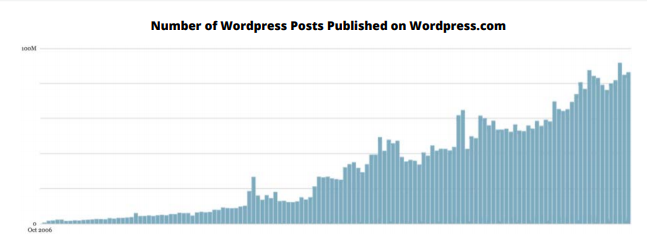
This growth in content has not been matched by growth in engagement. As shown below, page views of posts published on wordpress.com, have declined over the last 6 months.
2. Content Saturation Makes it Hard to Stand Out
BuzzSumo’s data reveals that as topics become more popular, there is often an explosion in published content which saturates the topic area. An example is Bitcoin, which became a very popular topic at the end of 2017. There were over 40,000 articles about Bitcoin published weekly by December 2017.
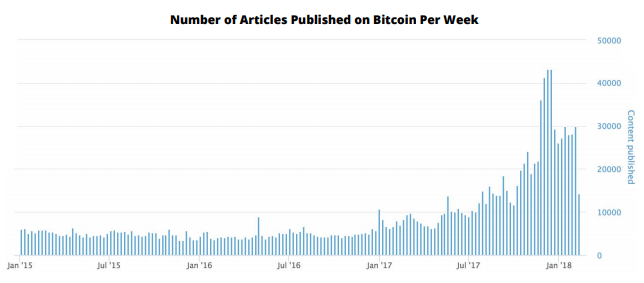
3. Social Traffic vs Search Traffic
In 2016, Facebook was driving more referral visitors to publishers than Google sites.
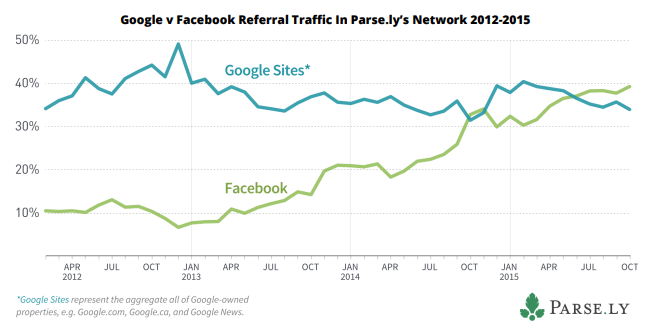
In 2017 the position has reversed markedly, with Google sites now sending twice as much traffic to publishers in the Parse.ly network.
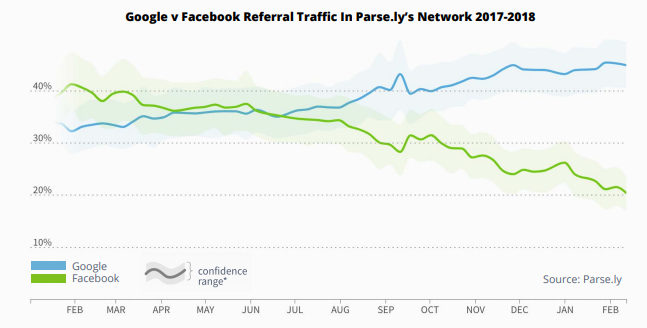
Recent data published by Shareaholic on 22 February 2018 shows a similar picture of declining social referrals.
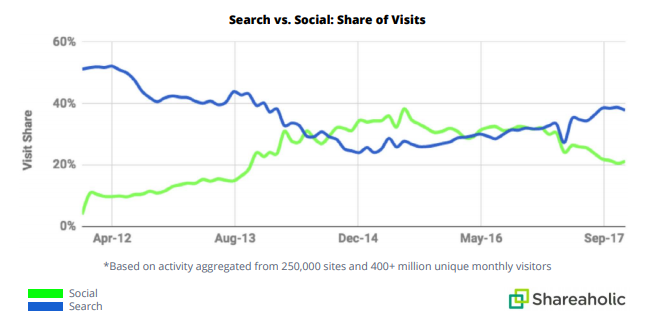
The decline in social referrals is almost entirely due to falling Facebook referrals as we can see from the chart below.
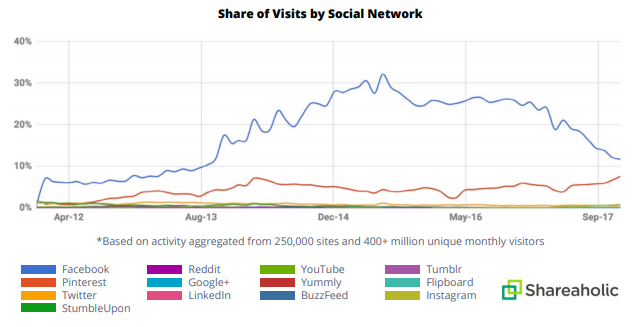
4. Content Volume Growth vs Engagement
In many topic areas, the rise of content volume results in drop of the average number of shares per article. Below chart shows the number of articles published on machine learning and the average Twitter shares.
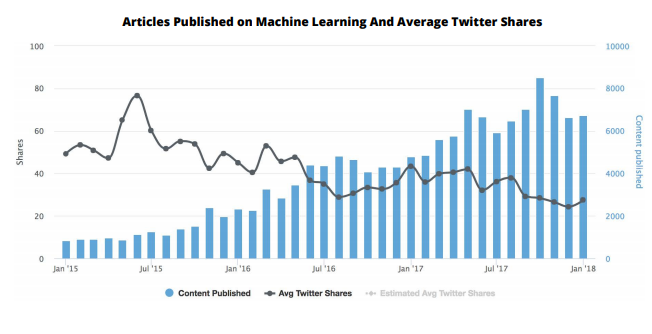
Recent Facebook Changes Make It Harder to See and Share Content
Facebook algorithm changes have adversely impacted organic reach and distribution for brands and publishers using the platform.
5. Growth in Private Sharing
Social messaging has surpassed social media usage. More people are using the top four social messaging apps (WhatsApp, Messenger, WeChat, and Viber) than the top four social media apps (Facebook, Instagram, Twitter, and LinkedIn).
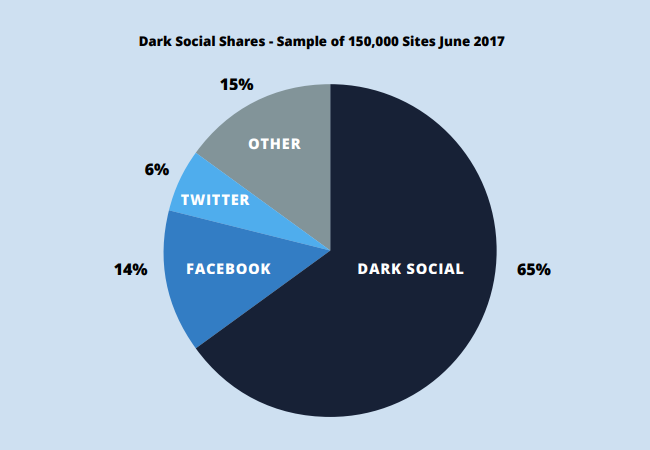
6. Content Discovery Sources
Research from Hubspot reveals that people find content through channels other than Google and Facebook. Today, for example, more people discover content through mobile notifications and Slack channels. Owned websites and email newsletters also rate highly.
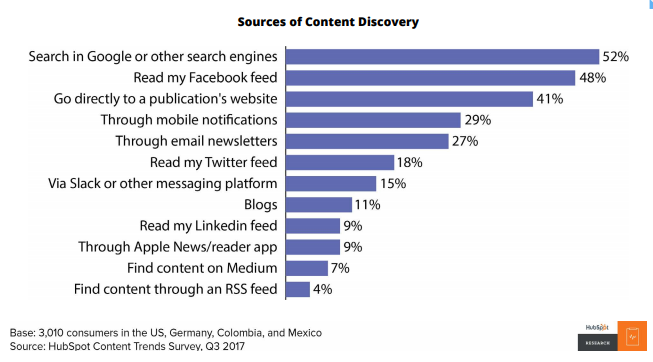
7. Social Sharing of Content Diminishes for Many Popular Sites
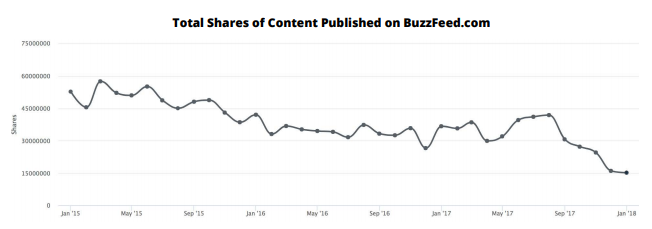
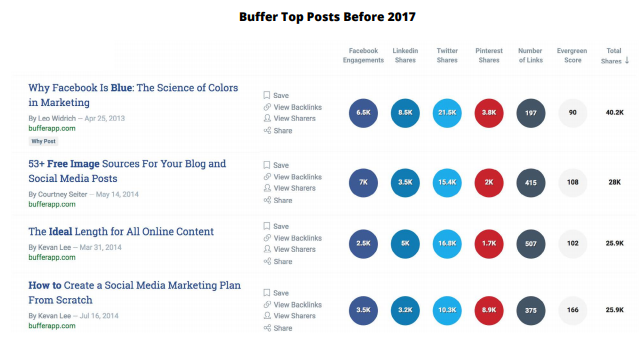
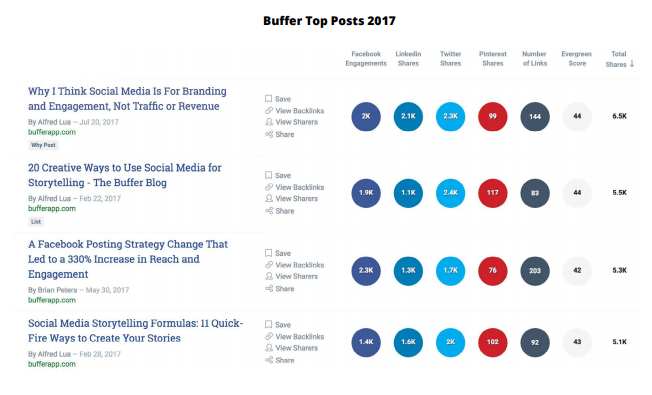
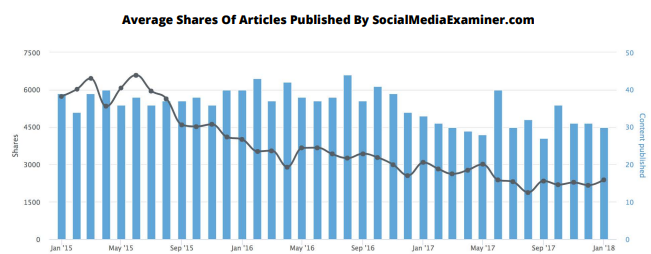
8. Quality Matters
People are now more selective in their sharing. So, if you’re going to share something with your audience, you want to make sure it’s well-researched and authoritative from a trusted source. We’ll use The New York Times as an example. The newspaper’s average shares have increased over the years (as shown below):
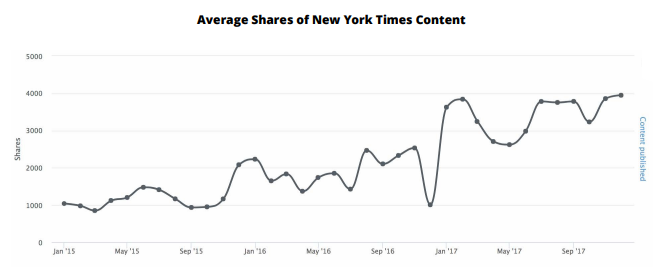
9. Growth in LinkedIn Sharing
While social engagement with content is steadily declining on Facebook and Twitter, many B2B publishers are seeing quite the opposite on LinkedIn. For example, here’s a chart showing the number of LinkedIn shares of content published on Forbes.com.
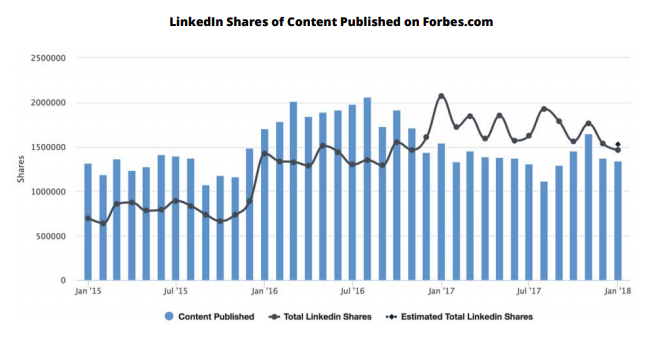
By contrast, here’s a chart showcasing the amounts of shares of Forbes.com content on Twitter.
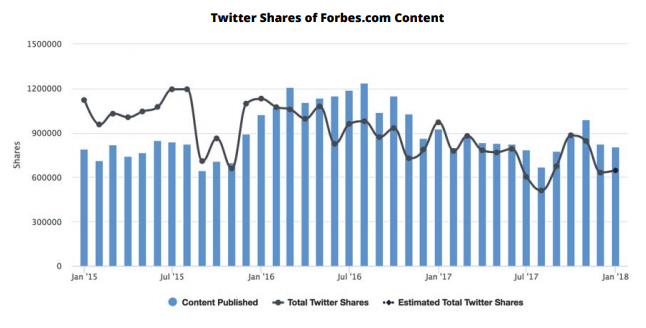
10. Backlink Trends
Over 70% of all published content is never linked to another domain. Given that link building is a key objective for many marketers, this is a little worrying. However, backlinks are earned consistently by authoritative sites.
11. Evergreen (Relevant) Content Builds More Links and Shares
Despite the aforementioned declines in social sharing, we still find posts that are consistently shared and linked to over time. These types of posts are known as evergreen content. Below are some examples.
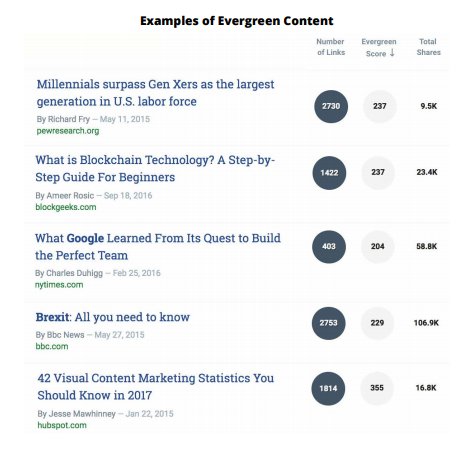
More content trends can be found in Buzzsumo’s Content Trends Report 2018 by Steven Ryson.
12. Visual Content
-
37% of marketers said visual marketing was the most important form of content for their business, second only to blogging (38%). (Source)
-
74% of social media marketers use visual assets in their social media marketing, ahead of blogs (68%) and videos (60%). (Source)
-
When people hear information, they're likely to remember only 10% of that information three days later. However, if a relevant image is paired with that same information, people can retain 65% of the information three days later. (Source)
-
B2C marketers place greater importance on visual content than B2B marketers. (Source)
-
51% of B2B marketers prioritized creating visual content assets in 2016. (Source)
13. New Generation Interactive Content Marketing Platforms
In light of the above, marketers can benefit from a centralized platform that solves all their content marketing needs (content creation, distribution, lead generation, CRM, etc.).
Joomag is one of those platforms. Today, more than 500,000 businesses worldwide are using Joomag’s content marketing platform to create interactive digital content, distribute it through multiple distribution channels, generate leads, and collect valuable data. With this data, companies can study their audience’s behavior and fine-tune their content marketing strategies. The chart below proves just how popular Joomag has become with businesses large and small over the years.
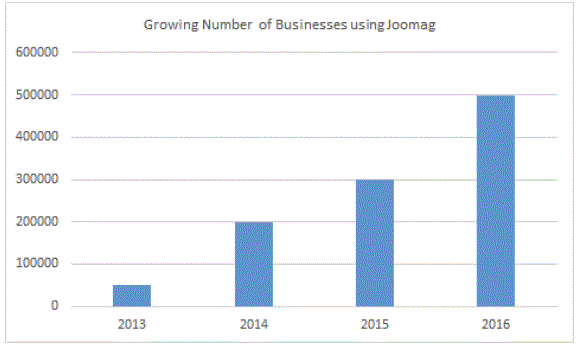
Conclusion
Content marketing trends are changing. Relevant, interactive, visually engaging, and personalized content that provides valuable information to consumers always wins. Marketers must rethink their content strategies and adapt to new trends accordingly. If not, they will fall behind.
Plan and Execute Your Content Marketing Strategy with Joomag!
FAQ
Q: How can marketers adapt their strategies to the 2018 trends?
A: Marketers should focus on integrating interactive and visually engaging content, optimizing for new search behaviors like voice search, and ensuring their content offers real value to improve user experience.
Q: What methods are recommended for measuring the success of these new strategies?
A: Success can be gauged through engagement metrics, conversion rates, and improvements in SEO rankings, with a focus on data-driven insights to refine content strategy.
Q: What should marketers anticipate beyond 2018 in content marketing?
A: Marketers should prepare for ongoing changes, including more personalized content, the increasing role of AI and machine learning, and evolving consumer expectations for interactivity and value.
Sources:
- https://d380wq8lfryn3c.cloudfront.net/wp-content/uploads/2018/03/05105230/BuzzSumo-ContentTrends-v8.pdf
- https://d380wq8lfryn3c.cloudfront.net/wp-content/uploads/2018/03/05105230/BuzzSumo-ContentTrends-v8.pdf
- https://d380wq8lfryn3c.cloudfront.net/wp-content/uploads/2018/03/05105230/BuzzSumo-ContentTrends-v8.pdf
- https://www.singlegrain.com/blog-posts/content-marketing/7-types-of-interactive-content-why-and-how-to-use-them/
- https://blog.hubspot.com/marketing/visual-content-marketing-strategy
- https://www.joomag.com/en/about-us
